Since returning from Iceland, and absorbing myself in the novels of Halldór Laxness, I have found myself constantly musing on the resourcefulness and ingenuity of the Icelandic people. In contemporary terms, geothermal energy might lead us to regard Iceland as relatively resource-rich, but until recently it has been in many other respects, incredibly resource-poor. Growing seasons are short and few crops thrive in cool summers. In many parts of Iceland, the weather can be pretty wild; the landscape does unpredictable things — such as divide and erupt — and there are few trees, which meant that wood could rarely be used for either building material or fuel. I love vernacular architecture – to me it is the ultimate expression of the human sense of place, saying so much about the relationship between human bodies and the landscapes that surround them. Iceland’s vernacular architecture is particularly distinctive and expressive.
These are Icelandic turf houses, of which we saw a handful of extant examples, and several careful reconstructions at the museums of Árbæjarsafn and Skógar, both of which I highly recommend. They have some similarities with the Hebridean black houses with which I’m familiar, but differ from their Scottish counterparts in that turf not only forms the roof, but is also used as a building material for the walls, being packed into the cavities left by dry stone work to further insulate the building. Having been inside a couple on a very wild day, I can confirm that turf houses are incredibly cosy and impervious to the elements – which would of course be just what their inhabitants required. But they are also relatively high-maintenance constructions, as the turf cladding requires care and renewal every couple of decades or so. This may account for their relative rarity, as may the poor regard in which they are apparently held by some Icelanders. Again, I was reminded of the Hebrides, where black houses might be thought of as shameful, peasant dwellings, and were condemned by eighteenth- and nineteenth-century “improvers” as signs of island backwardness and barbarity, rather than what they actually are: that is, an ingenious human adaptation to the requirements of life in a specific landscape. In Eighteenth-Century Iceland, the traditional stone-and-turf construction was modernised with wooden gable ends and these burstabær – which were still constructed and maintained up until the 1940s and 50s – are the most commonly seen examples extant today.
Like their counterparts in the Hebrides, Icelandic turf houses really speak both to and of the landscapes from which they emerge, and indeed into which they meld. I very much enjoyed exploring them.
Here is another distinctively Icelandic made thing which I can’t stop thinking about.
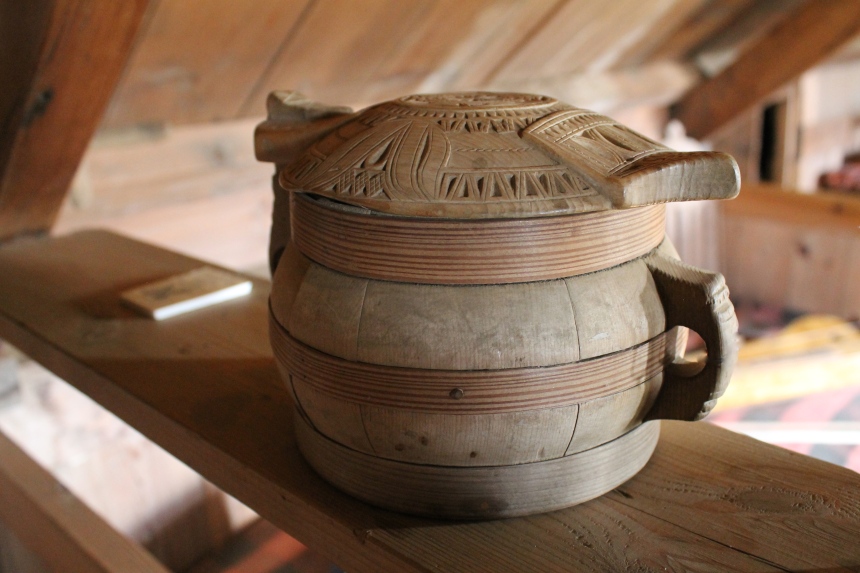
(image reproduced from here)
This beautiful object is an Askur – an Icelandic food bowl.
The barrel-like section was designed to hold soup or porridge, while the lid flipped out and might be used as a plate. This ingenious dual-purpose construction made the askur ideal for consuming food on one’s knees, rather than a table, as would have been common in many Icelandic homes. These are objects with a purpose, built for a specific use, in a specific environment, but they are also incredibly beautiful, personally-prized decorative objects. Askur might be hand-carved with intricate designs, and decorated with their owner’s initials.
They are mostly carved from driftwood and the fact that their designers transformed a found object into a made one makes them even more beautiful to me. These are practical, ordinary items built for the practical, ordinary business of feeding oneself. But they are also unique ornaments, carved from a rare and precious resource. I’d take an Askur over a Faberge Egg any day.
Both of our guides at Árbæjarsafn and Skógar spoke of the fact that Askur are still regarded by many Icelanders as objects of shame: the signature of a culture lacking the kind of developed industry which might have produced porcelain crockery. But to my mind the Askur should be regarded with great reverence and pride: an ingenious every-day object, a signature of a nation’s resourcefulness and creativity, as well as a testament to the skill of its individual maker.
Yesterday I read these typically thoughtful words on one of my favourite blogs:
“Craft work can be seen as preserving time. Hand made items preserve time in the same way that fruit is preserved as jam, not as the unchanged strawberry or plum fresh plucked, but as something cooked and processed to preserve the taste of summer. Hand made items embody both the hours of making (time) and memories and feelings of people (the times) within the construction of the object . . .a true cultural artefact.”
This is one of the many reasons I love making and reflecting on making, and why I found the Icelandic Askur an impressive and important and deeply moving cultural artefact. I’ll leave you with some other Icelandic made things I also found moving and inspiring: beautifully carved, and just as beautifully knitted, embroidered, crocheted, and woven driftwood chairs and cushions from Skógar.
If anyone has recommendations for further reading about Icelandic vernacular architecture, or traditions of driftwood-carving and askur-making I would be very grateful!



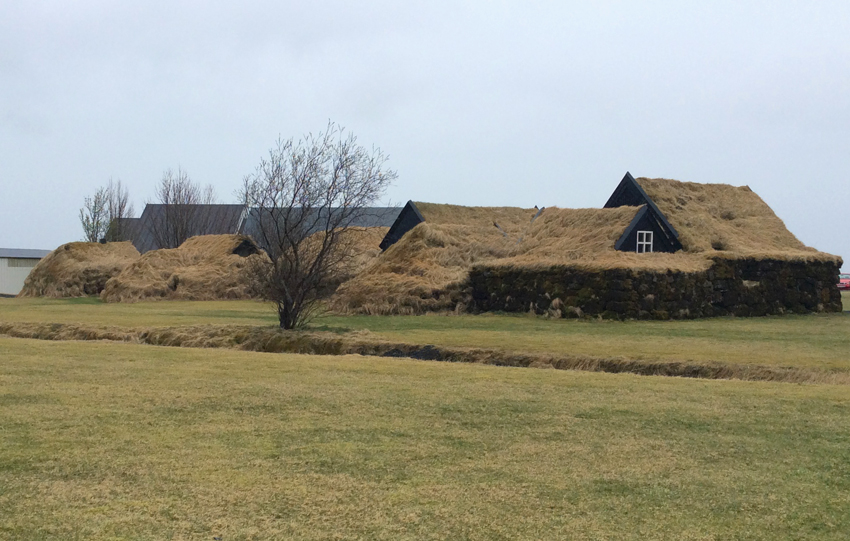
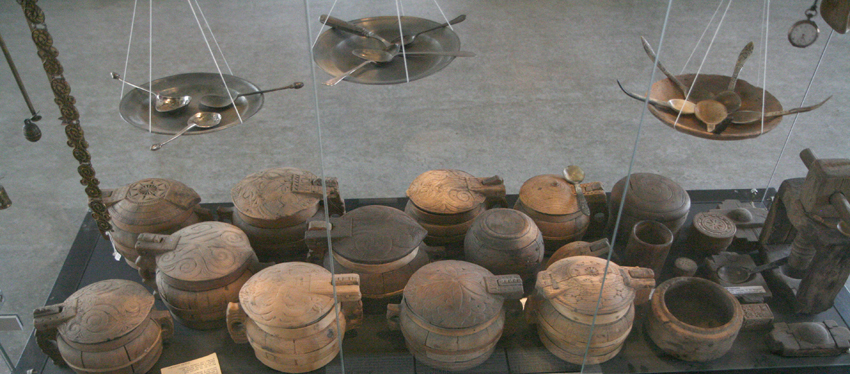
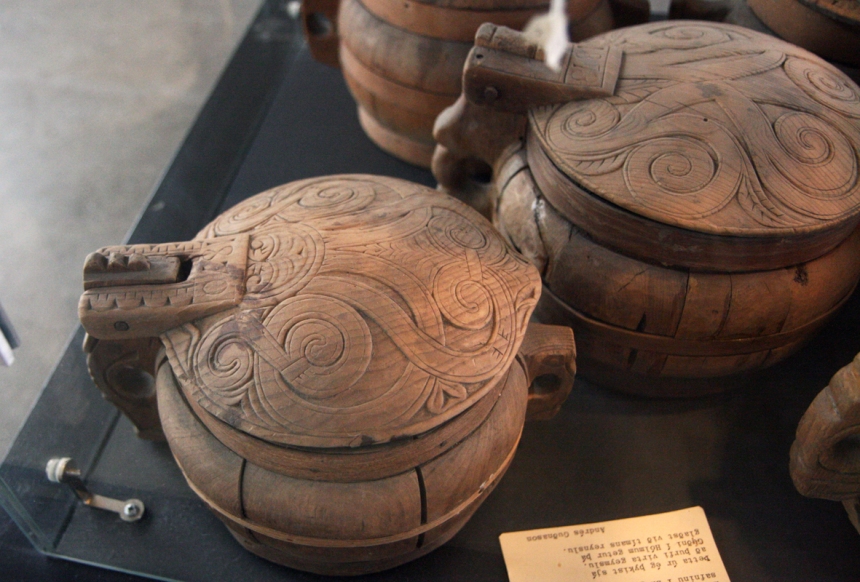
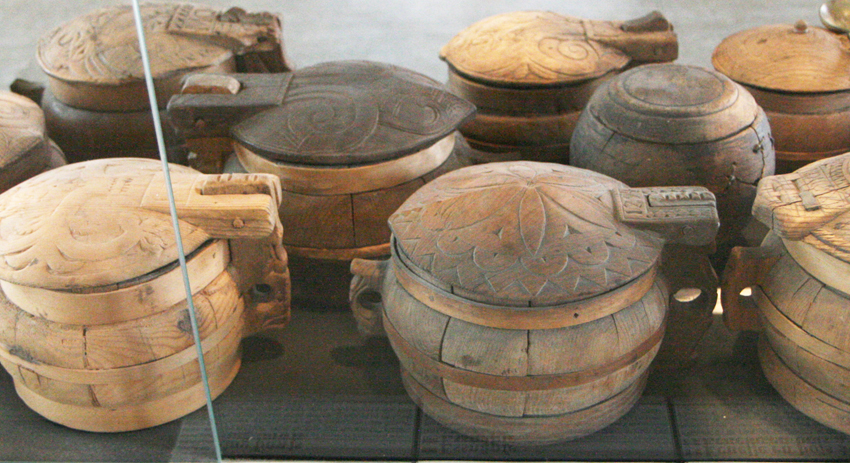
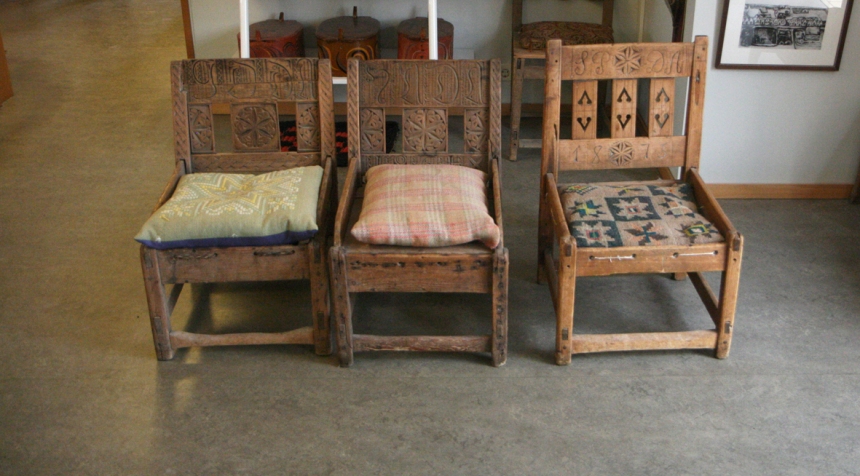
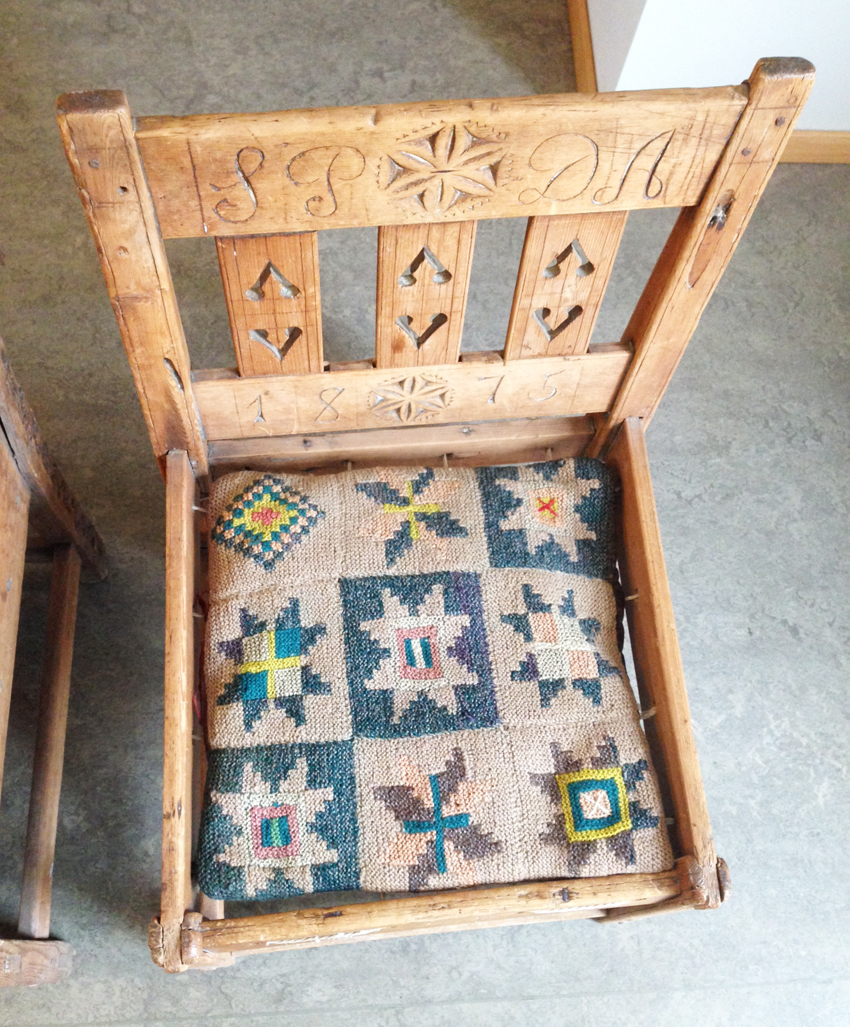
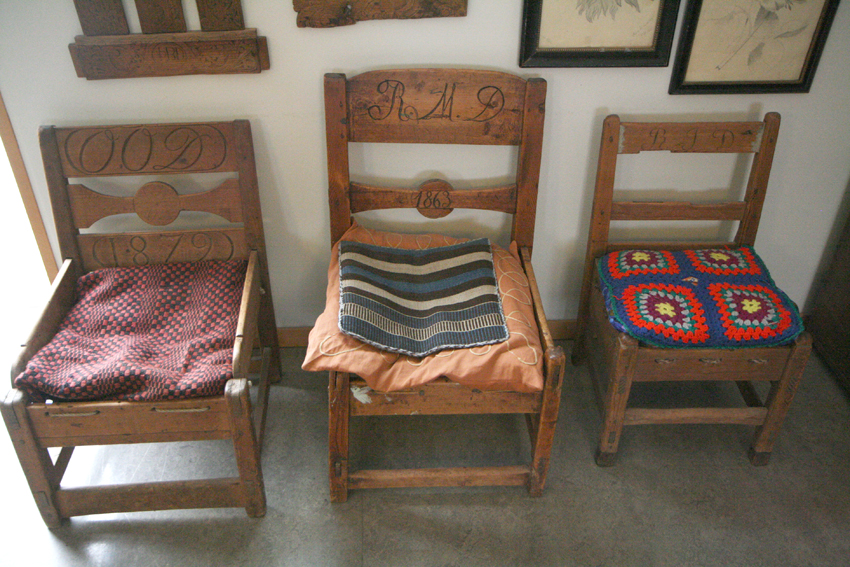

I just returned from Iceland yesterday. My favourite things were the Askur in the Skogar Museum. I tried to find one to bring back home to Switzerland. I ask serveral locals, but only a few new about this…
Kind regards
Ralph
LikeLike
I was in Iceland and missed all this! I agree about the Faberge egg! Thanks for a great post, it certainly has generated a lot of responses! Can’t wait for the new book!
LikeLike
Like many of us, I make things by hand and love handmade things – and have been struck by the beauty of the items you have included in your post. The cushions on the chairs reminded me that I have a book by Jona Sparey titled “Icelandic Patterns in Needlepoint”, published by David&Charles in 1993. Some of the designs in the book are based on items in the National Museum at Reykjavik. The Askur lids in your photographs also offer some interesting ideas for needlework designs; it is wonderful how patterns can migrate from one medium to another. Winter here in Tasmania will soon be with us, bringing time and opportunity to develop some ideas for new projects. Thanks, Kate!
LikeLike
Such an inspirational post,thank you Kate! I have looked on the mistery that is Iceland for a long time. You speak of it and it’s traditions with such love,respect and admiration! You speak from the heart,directly to my soul. Thank you for sharing your journey!
LikeLike
I loved this post!
LikeLike
Gorgeous and inspiring, all of it.
LikeLike
This is a great posting! It never ceases to amaze me how handmade items are underappreciated…rather sad. But it does not stop me and my whole family – it is our lifeblood…
LikeLike
Thank you! Needed that this morning.
LikeLike
Really fantastic (and fascinating) post. I think your reflections are spot on.
LikeLike
I love, love this post :) What beautiful things are made out of necessity, to which I might also include the need for beauty in everyday life, too. How inspiring. Thanks for the link. I wish I could add to your reading list but all I can think of is H. Magnusson’s book Icelandic Knitting: Using Rose Patterns (you likely know it already), in which she writes about her study of traditional Icelandic shoe inserts. To think that people would spend so much time and thought into making such beautiful additions for the humble foot that would never even see the light of day when worn! Fascinating stuff, this is. I’m so glad you are sharing your discoveries with us :) Have a lovely day.
LikeLike
Ha, just noticed this topic has already been addressed!
LikeLike
Your Iceland posts are wonderful! I am enjoying the history tour and learning the little snippets along the way. I often wonder how such great knitting came from such dark homes in Iceland or any of the northern climates. Thank you again for the nice little trip to Iceland.
LikeLike
Innovative and resourceful people that, no doubt, spent many a long winter evening carving, knitting, and “weaving” their hearts and souls into functional, everyday objects that shine with artistry. A wonderful post. Thank you!
LikeLike
I have been wanting to go to Iceland for 30 years so hope it will still happen – until then I will live vicariously through your and others’ blogs and photos and dream of the landscape, the ponies, the wool, the culture… ;) Thanks!
LikeLike
One of those chair pillows reminds me of Icelandic insert knitting, described into detail in “Icelandic Knitting: Using Rose Patterns”. Another wonderful example of make-do handmade objects lovingly made with scraps. Thanks for your thoughtful post!
LikeLike
Laxness is not easy going; good for you! I read two of his novels when I visited Iceland. When I asked a friend (a librarian who reads EVERYTHING) whether she’d read his book, she just laughed at me!
LikeLike
Your post reminds me how alienated from the land we have become. It is rare now to use local materials to make a house. And it seems we are perched upon the land precariously without connection to it or knowledge of it.
I am so glad you enjoy my blog and flattered that you found my words pertinent.
LikeLike
Love the story of your trip and the askur carving on the lids just flows the are beautiful the chairs look like they would need a cushion just to be able to sit on them for any length of time thamkyou so much for the beautiful photos
LikeLike
The askur with their intricate carvings are very beautiful indeed; great craftmanship. Thank you for sharing.
LikeLike
This makes me want to get back to Laxness! Go make something! Go back to Iceland!!! Skogar was just an unbelievable museum. I still haven’t gotten over the fish skin shoes.
LikeLike
I am new to your blog, and am enjoying it very much. Thank you for sharing your insight, skill and perspective.
LikeLike
Fantastic info on Iceland, somewhere I have always wanted to visit. Your photos and writing are outstanding and give so many of us a great deal of pleasure. I have read many of the books you have suggested before and now there are more to try.
LikeLike
Kate, did you by any chance take photos of the inside of the “black houses”? I am curious to see how the inside was finished. If they had very little wood, how did they finish the inside walls or were they sod also? It seems like it would be virtually impossible to keep clean with dirt floors, walls, and ceilings as well. Thank you for any information you can share.
LikeLike
Wonderful posts from Iceland, thank you, Kate! And as always, I love read others’ replies – especially book recommendations!
LikeLike
Kate – this is a wonderful post. I am very much enjoying your pictures of Iceland. You may be very familiar with both these books. I am reading Hannah Kent’s “Burial Rites” at the moment ( along with many others I think). Much of the story is set within the badstofa of a turf house, the sense of cosy dankness and claustrophobia in contrast to the wild and dramatic landscape outside. Also a modern travelogue, “Strangers in Iceland” by Sarah Moss who is an academic who spent a year with her young family living and teaching in Reykjavic at the time of the financial crisis and the eruption of Eyjafjallajökull. Her observations of modern Icelandic culture are really interesting. Can’t wait to read more and to see your designs.
LikeLike
OH, what a treat this post was! Thank you, thank you. I too read the piece that was on ‘one of your favourite blogs’. Mine too!! She had the right of it. Those ‘old’ things you showed give me the shivers, they are so extraordinary. I am starting The Good Shepherd by Gunnar Gunnarsson, recommended to me by THECRAZYSHEEPLADY……..NOT :)
take care.
LikeLike
I just love this post. Your photos and history telling are great.
LikeLike
Really enjoying your posts about Iceland. I share your appreciation for hand-crafted ‘things’ (a good Norse word, that) and am interested in the comparisons between these turf houses and Hebridean black houses. I have a friend whose partner is Icelandic: they meet up with his parents sometimes in Orkney, half-way between their homes in Scotland and Iceland. The parents consider Orkney the soft south!
LikeLike
I’ve thoroughly enjoyed reading about Iceland and all the goodies you’ve provided through photographs for us to enjoy. Thanks for sharing your trip to Iceland, a country on my list to see and experience.
LikeLike
Thanks for sharing all things Icelandic!! The pillow cushion covers are simply lovely. I wonder if the people who made them thought they were lovely or just practical?
LikeLike
After my own trip to Iceland, I am reading Laxness as well.
LikeLike
You see the modernization of vernacular architecture here in America as well. Our log homes have been “improved” over the years. Some were re-sided with wood boards to hide the common style, and beautiful oak floors were covered in carpeting. Now log homes are greatly prized. Nowadays it’s a great thing to find and restore one of these covered log cabins. So perhaps in Iceland the old styles will return as more people in the country learn about the old ways and sustainable architecture from museums like the one you visited. As for the askur, what a beautiful object. I wonder, are they being reproduced at all, say, for the tourist industry? I would buy one in a shot. Thanks, Kate, for sharing your Icelandic experience.
LikeLike
These are beautiful and ingenious. And the houses too! Thanks so much for sharing your lovely trip.
LikeLike
Oh, askur!!! We have the one that traveled with my Icelandic great-grandfather, it is the most gorgeous carved object! Also, a couple hundreds year old Illuminated family Bible in Icelandic, one of the big variables in Icelandic literacy, the printed Icelandic bible. My father and uncle, now dead, returned the bible to Iceland, to Borganas, the last known place where my great-grandfather worked on rented land before he and his family were cut down by a measles epidemic. His wife and three of the six children died, he went into a month long coma, the “parish” placed the children I homes and distributed the few sticks of furniture, left the children and he came to Canada and then Blaine, Washington in the USA. So many of the details that are played out in Laxness’ novel Independent People. Nest robbing, stream fishing and mutton….
LikeLike
Thank you for these lovely Iceland posts! I spent two weeks there a few years ago and you’re making me want to go back. We toured the south, as it was September and the north was expecting a snow storm (which subsequently buried a bunch of sheep, as the rettir hadn’t yet happened. I think they managed to dig most of the hapless things out). There’s still the north for me to see, and the even more remote Westfjords!
There’s something inherently calm and almost spiritual about the whole place. It felt surreal the whole time we were there. Thanks for bringing some of that feeling back.
LikeLike
Lovely descriptions and photographs. I have a sort of connection to Faberge eggs because one of my ancestors was the chief designer for Faberge, but these are more my style as well! They remind me of Swiss designs for some reason (which is interesting because he was Swiss) oh well. Rambling on this morning!
LikeLike
The Appenzell region has a continuing tradition of exquisite woodworking of vessels used for cheesemaking, and these are often skilfully carved, too. Also, the men’s traditional costume involves braces (suspenders) that are leather with intricately decorated brass ornaments and their jackets feature beautiful embroidery. Never mind the intricate perfection of the various women’s costumes involving weaving, embroidery, knitting, crochet, silverwork and more…! The nice thing is they still do all this for themselves, regardless of the tourism trade, though of course that helps to keep people fed, realistically.
LikeLike
Ah, maybe that is the purpose for this wooden implement that I have that my great-great aunt painted. It looks like a scoop with a hook on the end of the handle. I know it’s a common design because I’ve come across modern ones. She lived in Canton Vaud. I wish I could see more of what you describe. Thanks for your response.
LikeLike
I’m reading Independent People by Halldór Laxness and these images give me something to picture. I love the idea of living with the earth and do what I can with my own house to to keep nature wild around me.
LikeLike
I so like the phrase “Icelandic vernacular architecture”. Such a beautiful post, Kate.
LikeLike
Your post has reminded me that here in Canada we have had extensive population of people
from Iceland. Check the Wikipedia article, Icelandic Canadians,I suspect it will help you on
your search.
Some of their distinctive designs are occasionally seen at craft and art shows.
LikeLike
This is wonderful, Kate. You’re absolutely speaking my language here! I quite agree with the parallels between the Hebrides and Iceland; just one of the many historic connections between the communities. When I think of turf houses over here I’m led straight away to thinking of displaced families during the clearances, where turf houses were occupied in some places following clearance. Of course the tradition runs for thousands of years longer, and with a rich (less tragic) heritage of its own. I can’t find the link but I think there was something published recently about Pictish turf houses.
Otherwise, maybe these publications will interest you: http://www.euppublishing.com/doi/abs/10.3366/E135075240900017X and https://www.eymundsson.is/nanar/?productid=c35e3321-8107-438f-80b8-565a42e6a1d6
The askur reminds me of a tiffin box.
Best,
Anna
LikeLike
I love this post. This is right up my street. I have great respect for communities who use what they have around them to build and provide for their families. Fundamentally, what more can you do for your loved ones. These artefacts have been made simply and honestly with no pretentions.
The Askur reminded me of a lunch I went to where the host was Icelandic and the salt box on the table was from Iceland. It was simply made but with lots of carving, so – although it was ‘just’ a salt box – someone had taken time to make it the best that they could. I loved it.
The good thing about the objects that you have shown is that you can see the signs of wear which makes the wood so smooth. You can’t buy that – it only comes from being used.
It reminds me of my late mum’s darning mushroom which is worn and sooth with signs of wear and I cannot count the number of socks which would have been darned using it.
Thanks, Kate.
LikeLike
I found the turf houses fascinating–we called them sod houses used by the early settlers of the U.S. midwest–I was from Nebraska, and my grandparents started married life in one of them!! Wood was scarce and the sod was plentiful, removed before plowing the prairie.
LikeLike
I love the Askur, what a wonderful object. I hope you’re enjoying the Laxness, such fantastic characters. x
LikeLike
Interesting post and beautiful. Thanks Kate.
LikeLike
My local yarn store has a sign outside of a wild-eyed person shouting “MAKE ALL THE THINGS!” – a view with which I have much sympathy (she says, just about to sign up for a woodworking course). But I have friends who simply don’t get it – have no idea why anyone would make something rather than buy it – and I have no idea how to explain it to them!
LikeLike
I very much like the idea of found to made, no waste, everything valued and rightly so. Thank you for such a thoughtful post.
LikeLike
So beautiful! The chair cushions are exquisite. More my taste than a Faberge Egg, also.
LikeLike
What a wonderful post Kate! Thank you for going to the trouble of so many great close up photos. I find the chairs particularly beautiful and quite agree that there is much to be proud of in making such lovely and useful objects from found objects. Spells true harmony with nature and the flow of life. The knitted covers also are stunning. Loving your Iceland posts.
LikeLike